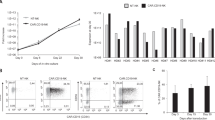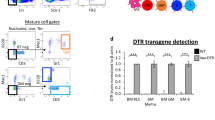Abstract
To investigate to what extent myeloablation, graft size, and ex vivo manipulation influence the engraftment and long-term survival of transduced murine hematopoietic cells, groups of C57BL/6J (CD45.2) mice receiving total body irradiation (TBI) (1–9 Gy) or no irradiation were transplanted with either transduced bone marrow (BM) cells, at two cell doses, or with fresh BM cells from B6/SJL (CD45.1) congenic mice. Short (40 days) and long-term (5 months) engraftment and transgene expression were measured by FACS analysis. No donor cells were detected in the hematopoietic tissues of non-myeloablated mice, whereas in the irradiated animals, levels of engraftment correlated well with the dose of TBI administered. Similar percentages of transgene-expressing cells were found in the grafted hematopoietic cells of all groups of mice, regardless of the dose of TBI administered or the level of engraftment achieved. This suggests that the engrafted animals could become tolerant to the transgene product (enhanced green fluorescent protein, EGFP). Our results indicate that TBI facilitates the engraftment of manipulated hematopoietic cells in a dose-dependent manner, that mice engrafted with EGFP+ hematopoietic cells probably acquire tolerance to EGFP, and that increasing the graft size and reducing the ex vivo manipulation required for retroviral gene transfer of hematopoietic cells also enhances their engrafting potential.
This is a preview of subscription content, access via your institution
Access options
Subscribe to this journal
Receive 12 print issues and online access
$259.00 per year
only $21.58 per issue
Buy this article
- Purchase on Springer Link
- Instant access to full article PDF
Prices may be subject to local taxes which are calculated during checkout



Similar content being viewed by others
References
Kiem HP et al. Improved gene transfer into baboon marrow repopulating cells using recombinant human fibronectin fragment CH-296 in combination with interleukin-6, stem cell factor, FLT-3 ligand, and megakaryocyte growth and development factor Blood 1998 92: 1878–1886
Schilz AJ et al. High efficiency gene transfer to human hematopoietic SCID-repopulating cells under serum-free conditions Blood 1998 92: 3163–3171
Conneally E, Eaves CJ, Humphries RK . Efficient retroviral-mediated gene transfer to human cord blood stem cells with in vivo repopulating potential Blood 1998 91: 3487–3493
van Hennik PB et al. Highly efficient transduction of the green fluorescent protein gene in human umbilical cord blood stem cells capable of cobblestone formation in long-term cultures and multilineage engraftment of immunodeficient mice Blood 1998 92: 4013–4022
Barquinero J et al. Efficient transduction of human hematopoietic repopulating cells generating stable engraftment of transgene-expressing cells in NOD/SCID mice Blood 2000 95: 3085–3093
Van Beusechem VW, Valerio D . Gene transfer into hematopoietic stem cells of nonhuman primates Hum Gene Ther 1996 7: 1649–1668
Simonaro CM et al. Autologous transplantation of retrovirally transduced bone marrow or neonatal blood cells into cats can lead to long-term engraftment in the absence of myeloablation Gene Therapy 1999 6: 107–113
Slavin S, Strober S, Fuks Z, Kaplan HS . Long-term survival of skin allografts in mice treated with fractionated total lymphoid irradiation Science 1976 193: 1252–1254
Slavin S, Strober S, Fuks Z, Kaplan HS . Induction of specific tissue transplantation tolerance using fractionated total lymphoid irradiation in adult mice: long-term survival of allogeneic bone marrow and skin grafts J Exp Med 1977 146: 34–48
Durham MM et al. Cutting edge: administration of anti-CD40 ligand and donor bone marrow leads to hemopoietic chimerism and donor-specific tolerance without cytoreductive conditioning J Immunol 2000 165: 1–4
Naparstek E et al. Engraftment of marrow allografts treated with Campath-1 monoclonal antibodies Exp Hematol 1999 27: 1210–1218
Wekerle T et al. Role of peripheral clonal deletion in tolerance induction with bone marrow transplantation and costimulatory blockade Transplant Proc 1999 31: 680
Quesenberry PJ et al. Engraftment of hematopoietic stem cells in nonmyeloablated and myeloablated hosts Stem Cells 1997 15: 167–169
Rao SS et al. Stem cell transplantation in the normal nonmyeloablated host: relationship between cell dose, schedule, and engraftment Exp Hematol 1997 25: 114–121
Ildstad ST, Sachs DH . Reconstitution with syngeneic plus allogeneic or xenogeneic bone marrow leads to specific acceptance of allografts or xenografts Nature 1984 307: 168–170
Exner BG et al. Mixed allogeneic chimerism to induce tolerance to solid organ and cellular grafts Acta Haematol 1999 101: 78–81
Exner BG et al. Clinical applications of mixed chimerism Ann NY Acad Sci 1999 872: 377–385
Heim DA et al. Introduction of a xenogeneic gene via hematopoietic stem cells leads to specific tolerance in a rhesus monkey model Mol Ther 2000 1: 533–544
Peters SO, Kittler EL, Ramshaw HS, Quesenberry PJ . Murine marrow cells expanded in culture with IL-3, IL-6, IL-11 and SCF acquire an engraftment defect in normal hosts (published erratum appears in Exp Hematol 1995; 23: 568) Exp Hematol 1995 23: 461–469
Kittler EL et al. Cytokine-facilitated transduction leads to low-level engraftment in nonablated hosts Blood 1997 90: 865–872
Peters SO, Kittler EL, Ramshaw HS, Quesenberry PJ . Ex vivo expansion of murine marrow cells with interleukin-3 (IL-3), IL- 6, IL-11, and stem cell factor leads to impaired engraftment in irradiated hosts Blood 1996 87: 30–37
Sekhar M, Yu JM, Soma T, Dunbar CE . Murine long-term repopulating ability is compromised by ex vivo culture in serum-free medium despite preservation of committed progenitors J Hematother 1997 6: 543–549
Miller CL, Eaves CJ . Expansion in vitro of adult murine hematopoietic stem cells with transplantable lympho-myeloid reconstituting ability Proc Natl Acad Sci USA 1997 94: 13648–13653
Albella B et al. Preserved long-term repopulation and differentiation properties of hematopoietic grafts subjected to ex vivo expansion with stem cell factor and interleukin 11 Transplantation 1999 67: 1348–1357
Wognum AW et al. Stimulation of mouse bone marrow cells with kit ligand, FLT3 ligand, and thrombopoietin leads to efficient retrovirus-mediated gene transfer to stem cells, whereas interleukin 3 and interleukin 11 reduce transduction of short- and long-term repopulating cells Hum Gene Ther 2000 11: 2129–2141
Stewart FM et al. Long-term engraftment of normal and post-5-fluorouracil murine marrow into normal nonmyeloablated mice Blood 1993 81: 2566–2571
Blomberg M et al. Repetitive bone marrow transplantation in nonmyeloablated recipients Exp Hematol 1998 26: 320–324
Miller AD, Miller DG, Garcia JV, Lynch CM . Use of retroviral vectors for gene transfer and expression Meth Enzymol 1993 217: 581–599
McSweeney PA, Storb R . Mixed chimerism: preclinical studies and clinical applications Biol Blood Marrow Transplant 1999 5: 192–203
Vriesendorp HM, van Bekkum DW . Role of total body irradiation in conditioning for bone marrow transplantation Hamatol Bluttransfus 1980 25: 349–364
Tomita Y, Sachs DH, Sykes M . Myelosuppressive conditioning is required to achieve engraftment of pluripotent stem cells contained in moderate doses of syngeneic bone marrow Blood 1994 83: 939–948
Barquinero J et al. Myelosuppressive conditioning improves autologous engraftment of genetically marked hematopoietic repopulating cells in dogs Blood 1995 85: 1195–1201
Mardiney III M, Malech HL . Enhanced engraftment of hematopoietic progenitor cells in mice treated with granulocyte colony-stimulating factor before low-dose irradiation: implications for gene therapy Blood 1996 87: 4049–4056
Berger C et al. Nonmyeloablative immunosuppressive regimen prolongs in vivo persistence of gene-modified autologous T cells in a nonhuman primate model J Virol 2001 75: 799–808
Stewart FM et al. Lymphohematopoietic engraftment in minimally myeloablated hosts Blood 1998 91: 3681–3687
Stripecke R et al. Immune response to green fluorescent protein: implications for gene therapy Gene Therapy 1999 6: 1305–1312
Izembart A et al. In vivo retrovirus-mediated gene transfer to the liver of dogs results in transient expression and induction of a cytotoxic immune response Hum Gene Ther 1999 10: 2917–2925
Schiffmann R et al. Transfer of the human glucocerebrosidase gene into hematopoietic stem cells of nonablated recipients: successful engraftment and long-term expression of the transgene Blood 1995 86: 1218–1227
Kang E et al. In vivo persistence of retrovirally transduced murine long-term repopulating cells is not limited by expression of foreign gene products in the fully or minimally myeloablated setting Hum Gene Ther 2001 12: 1663–1672
Carter RF et al. Autologous transplantation of canine long-term marrow culture cells genetically marked by retroviral vectors Blood 1992 79: 356–364
Rosenzweig M et al. Efficient and durable gene marking of hematopoietic progenitor cells in nonhuman primates after nonablative conditioning Blood 1999 94: 2271–2286
Lutzko C et al. Genetically corrected autologous stem cells engraft, but host immune responses limit their utility in canine alpha-L-iduronidase deficiency Blood 1999 93: 1895–1905
Rosenzweig M et al. Induction of cytotoxic T lymphocyte and antibody responses to enhanced green fluorescent protein following transplantation of transduced CD34(+) hematopoietic cells Blood 2001 97: 1951–1959
Varas F, Bernard A, Bueren JA . Restrictions in the stem cell function of murine bone marrow grafts after ex vivo expansion of short-term repopulating progenitors Exp Hematol 1998 26: 100–109
Qin S et al. Competitive repopulation of retrovirally transduced haemopoietic stem cells Br J Haematol 1999 107: 162–168
Ramshaw HS et al. Engraftment of bone marrow cells into normal unprepared hosts: effects of 5-fluorouracil and cell cycle status Blood 1995 86: 924–929
D'Hondt L et al. Influence of timing of administration of 5-fluorouracil to donors on bone marrow engraftment in nonmyeloablated hosts Int J Hematol 2001 74: 79–85
Limon A et al. High-titer retroviral vectors containing the enhanced green fluorescent protein gene for efficient expression in hematopoietic cells Blood 1997 90: 3316–3321
Baum C et al. Novel retroviral vectors for efficient expression of the multidrug resistance (mdr-1) gene in early hematopoietic cells J Virol 1995 69: 7541–7547
Bodine DM, McDonagh KT, Seidel NE, Nienhuis AW . Survival and retrovirus infection of murine hematopoietic stem cells in vitro: effects of 5-FU and method of infection Exp Hematol 1991 19: 206–212
Lee JC, Hapel AJ, Ihle JN . Constitutive production of a unique lymphokine (IL 3) by the WEHI-3 cell line J Immunol 1982 128: 2393–2398
Acknowledgements
We wish to thank Juan Bueren and Jesus Martínez (CIEMAT, Madrid, Spain) for providing the donor mice, the personnel of the animal facility and radiation therapy of the Institut de Recerca Oncologica for their help, and Rainer Storb and Robert Tjin for the critical review of the manuscript. This work was supported by grants: FIS (99/1074 and 00/0771), Fundació La Marató de TV3 (98/2410 and 00/5410), and INHERINET, Quality of Life programme of the 5th Framework Programme of the European Commission (QLK3-CT-2001-00427). T Puig and L Luquín were supported by a predoctoral fellowship from CIRIT (Spain).
Author information
Authors and Affiliations
Rights and permissions
About this article
Cite this article
Puig, T., Kádár, E., Limón, A. et al. Myeloablation enhances engraftment of transduced murine hematopoietic cells, but does not influence long-term expression of the transgene. Gene Ther 9, 1472–1479 (2002). https://doi.org/10.1038/sj.gt.3301826
Received:
Accepted:
Published:
Issue Date:
DOI: https://doi.org/10.1038/sj.gt.3301826
Keywords
This article is cited by
-
Immunoresponse against the transgene limits hematopoietic engraftment of mice transplanted in utero with virally transduced fetal liver
Gene Therapy (2011)
-
Transgene Expression Levels Determine the Immunogenicity of Transduced Hematopoietic Grafts in Partially Myeloablated Mice
Molecular Therapy (2009)
-
Tolerance Induction in Experimental Autoimmune Encephalomyelitis Using Non-myeloablative Hematopoietic Gene Therapy With Autoantigen
Molecular Therapy (2009)
-
Permanent partial phenotypic correction and tolerance in a mouse model of hemophilia B by stem cell gene delivery of human factor IX
Gene Therapy (2006)
-
Hematopoietic stem cell gene therapy of murine protoporphyria by methylguanine-DNA-methyltransferase-mediated in vivo drug selection
Gene Therapy (2004)



